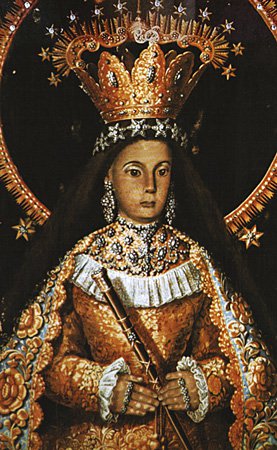Cultural Center of the Philippines
ENCYCLOPEDIA OF
PHILIPPINE ART
Nuestra Señora de la Paz y Buen Viaje de Antipolo
(Our Lady of Peace and Good Voyage of Antipolo) / Ca 1870 / Oil and casein on paper / Approximately 46 x 33 cm / Artist: Justiniano Asuncion / Leandro V. Locsin collection
The subject is a statue of the Virgin brought by Don Juan de Tabora from Acapulco, Mexico, in 1628. Upon Tabora’s death in 1632, it was given to the Jesuits. Assigned the title “Reina y Gobernadora de Nave Almirante” (Queen and Ruler of the Admiral’s Ship), the image accompanied the galleon La Encarnacion across the Pacific Ocean four times. It was given the name Virgen de Antipolo because native tradition says that it twice disappeared from the shrine and reappeared on top of the tipolo tree each time.
To successfully paint a verdadera imagen, an authentic portrait of the cult image, Asuncion was supposed to have fasted, knelt, and prayed in front of the statue. The result is a half-body portrait, which is a veritable trompe l’oeil, with all the jewels and the rich embroidery of her brocaded robe seeming to jut out from the painting. Mary also wears dangling earrings, rings on all her fingers except the thumb, crown of stars and a gem-studded gold crown, surmounted by an arch of golden rays and the bejeweled 12 stars of Juda, all realistically captured by Asuncion. A speck of white paint on the ball of her eyes gives the illusion that Asuncion painted a living person posed as the Virgin.
Written by Santiago A. Pilar
